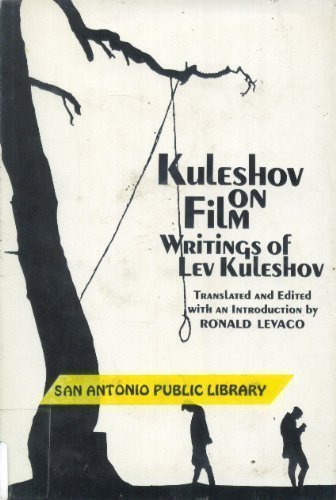Kuleshov on Film: Writings by Lev Kuleshov epub
Par nall craig le dimanche, mars 13 2016, 00:37 - Lien permanent
Kuleshov on Film: Writings by Lev Kuleshov. Lev Vladimirovich Kuleshov, Ronald Levaco

Kuleshov.on.Film.Writings.by.Lev.Kuleshov.pdf
ISBN: 0520026594,9780520026599 | 121 pages | 4 Mb

Kuleshov on Film: Writings by Lev Kuleshov Lev Vladimirovich Kuleshov, Ronald Levaco
Publisher: Univ of California Pr
This is a film editing montage effect named after Russian filmmaker Lev Kuleshov who first illustrated it in the 1910s and 1920s. Vsevolod Pudovkin (1893- 1953). The Kuleshov effect takes its name from Lev Kuleshov, an influential filmmaker in the mid-twentieth century Soviet Union, who illustrated it. A collection of links, fun and serious, on film and culture, to start the week. The year after The Gold Rush and Battleship Potemkin, Eisenstein's teacher Kuleshov turned in his own gold rush masterpiece. �We're still figuring out how we do it. Sergei Eisenstein & Lev Kuleshov. After spending the best part of two weeks in each other's company, we've really broken the back of it. In 1918 he conducted his famous experiment (below) using a single shot of the silent film actor Ivan Mozzhukhin's face looking at something off-camera. Through-out the films that Kuleshov was creating they contained propaganda a form of information that is biased to support a specific view (in this issue it was a government, political view). In this classic interview with Alfred Hitchcock he demonstrates the Kuleshov Effect. Classically, it's basically what editing is about in film; you create meaning by placing shots next to each other and then watch as they influence each other. Eisenstein believed that film montage could create ideas or have an impact beyond the individual images. In the early 20th century, Russian filmmaker and theorist Lev Kuleshov discovered that a single shot of an actor with an ambiguous expression on his face could convey a multitude of very distinct meanings in the mind of the viewer, depending on the nature of the shot immediately preceding it. It's a little hard to pin down precisely what the nature of his experiment was. This technique, described by critic Paul Arthur as “metaphoric The diametrical separation between films critically assembled from newsreels and the formalist “played film” frequently appears in the writings of Soviet editors. In the 1910s and 1920s, Lev Kuleshov was a famous Russian filmmaker curious about how audiences responded to film. Doublier, described as “the spiritual ancestor” of Lev Kuleshov, the Soviet montage theorist, uses the metaphoric properties of film to analogize the event where images do not exist.